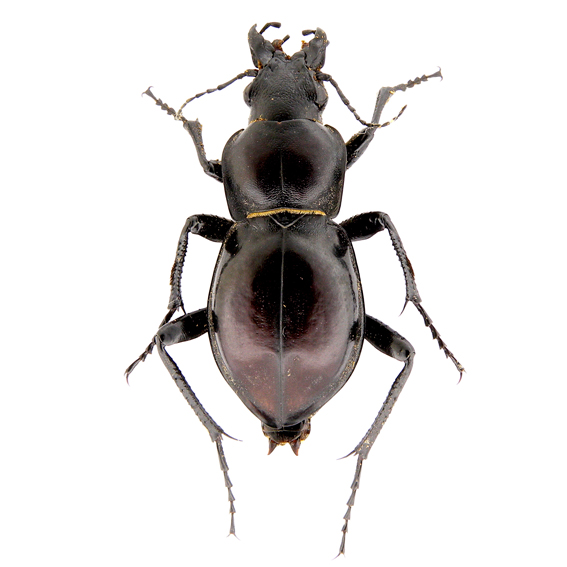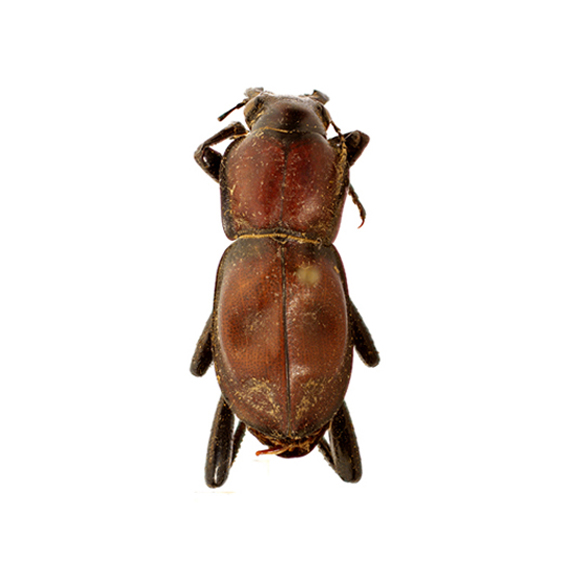Calosoma (Callisthenes) fabulosum Semenov-Tian-Shansky & Znojko, 1933
Calosoma (Teratexis) fabulosum Semenov-Tian-Shansky & Znojko, 1933: 100 (type locality: Irchailyk Pass); holotype ♂ in Zoological Museum of the Zoological Institute of the Russian Academy of Sciences, Saint Petersburg
Teratexis fabulosa Jeannel, 1940: 197
Callisthenes (Teratexis) fabulosus Kryzhanovskij, 1962: 180
Length 26-28 mm. C. fabulosum is a species with an hyper-development of head and pronotum, much more evident than in the related species C. mirificum, and with a pronounced sexual dimorphism.
The pronotum is longer than wide, more conspicuously so in males, with parallel sides and with posterior angles well developed, projecting sharply from the baseline. The elytra in the male have two deep depressions, one in the posterior third and another in the middle, this latter not present in the female. The middle tibiae are curved in both sexes, but far more in males and in this case they have a characteristic protuberance on outside, toward the apex. In males, also the hind tibiae are curved. The anterior tarsi of males, as happens in most species, are enlarged, but the first article, has an asymmetric protrusion on outside.
Both sexes have the upper body of an unusual reddish brown color. This same color has been noted, however, by Obydov (2002: 59) also on a specimen of C. mirificum.
These characteristics are more acccentuated in males that, until recently were the only known specimens. Consequently, the descriptors emphasized their importance (Semenov-Tian-Shansky & Znojko, 1933: 100), even speculating about a possible convergent evolution with Calosoma (Castrida) bridgesi, a South American mountain species, belonging to a very different group. To accomodate fabulosum, however, a separate subgenus, Teratexis, was created by its descriptors. It was accepted by Jeannel (1940), who even raised it to the rank of a distinct genus, while recognizing the common characteristics with other species of Callisthenes. Later Kryzhanovskij (1962) has re-proposed Teratexis as a subgenus of Callisthenes.
If we take into consideration the specific characteristics of C. fabulosum in the females, where are much less evident, we see that could represent a more advanced evolution of characteristics already present in C. mirificum, although they are less pronounced there. C. fabulosum could therefore constitute an extreme form of development within a well-defined group of Callisthenes, and hence have no need for an independent taxonomic status. In this hypothesis C. fabulosum should fall into the same phyletic lineage shared by other species of Callisthenes, most probably linked to the C. regelianum - C. mirificum group.
Umnov, was the first to collected C. fabulosum in an unidentifiable localiuty of north Afghanistan. He found eight specimens, all males (Semenov-Tian-Shansky & Znojko, 1933: 102), but of these, so far, only two were known.
Recently, both sexes were found in central eastern Afghanistan.
Examined material
Afghanistan. Bamian prov., Band-e Amir, 3000 m (AC, SB)
Notes: Brachypterous. It lives around 3000m. altitude. Adults were collected. in May - June.
 Semenov-Tian-Shansky & Znojko, 1933 Afghanistan: Bamian, Band-e Amir, 3000m, 25.05.2010 |
 Semenov-Tian-Shansky & Znojko, 1933 Afghanistan: Bamian, Band-e Amir, 3000m, 25.05.2010 |
 Semenov-Tian-Shansky & Znojko 1933 Afganistan: N. Afganistan, Irkailyk pass, 11.VI.1930, N. Umnov (Zoological Institute, Russian Academy of Sciences, St. Petersburg) (Holotypus) (photo Anichtchenko A. 2010) |